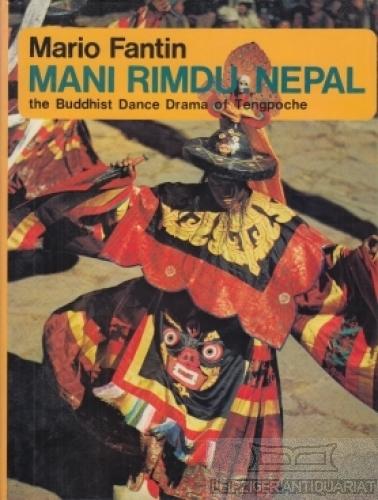Mani Rimdu
The Buddhist Dance Drama of Thyangboche
Fantin Mario

|
|
Editeur - Casa editrice |
The English Book Store
|
Asia
Nepal
Himalaya
Buddhismo
Cham |
|
Città - Town - Ville |
New Delhi
|
|
Anno - Date de Parution |
1976
|
|
Pagine - Pages
|
176
|
|
Titolo originale
|
Mani Rimdu - The Buddhist Dance Drama of Thyangboche
|
|
Lingua - language - langue
|
eng
|
|
|
|
|
|
|
|
|
|
|
|
|
|
|
|
 Mani Rimdu
Mani Rimdu

Reviewed by SHANTA SERBJEET SINGH
Where mountains soar to titanic dimensions and snow crested ranges peering from behind one another rent the blue skies, lies the monastery Thyangboche, 15,000 feet above sea level, right under the very nose of the Everest.
Thyangboche Gompa is famous for its annual staging of the Buddhist dance drama, Mani Rimdu, a set of ritual mask dances in which every musical instrument, costume, mask and theatrical prop is consecrated, along with the dancer, in special Tantric rites.
Though the dances are meant to celebrate the victory of Buddhism over the old Bon religion, the primeval power, passion and vigour of this miracle play par excellence suggests a continual meeting point with the common heritage of Tibet of antiquity.
The colour photographs by the author transports the reader to the hazy nether world of the high Himalayas-dance costumes of flaming colours, clear-eyed children, lamas, gods and animals. The book has all the visual ingredients of a popular, and expensive publication that makes an ideal gift.
Jarring: There are also detailed line drawings of the musical instruments and other props that complete the Mani Rimdu festival. A glossary of Tibetan or Tantric Buddhism as well as Sanskrit phrases would also be of help to the serious reader and tourist to get the most out of the experience of visiting or reading about the Mani Rimdu dances. But once you go beyond the illustrations and the special features, the text begins to strike a jarring note.
The author grinds facts and figures haphazardly and though some of the loss of poetic feel of the subject can be attributed to the translation from Italian into English by R. S. Ahluwalia, there is no doubt that the contents, to begin with, have the impress of a hybrid between a gazetteer and a travelogue.
|
|
|
|
Biografia |
|
Nato a Bologna da genitori friulani, Mario Fantin ha scoperto la montagna e l’alpinismo a 26 anni. Ha partecipato alla seconda guerra mondiale combattendo sul fronte albanese. Si è avvicinato alle Alpi dopo un corso di alpinismo, documentando le proprie ascensioni con la macchina fotografica: fu l’inizio di una lunga avventura come alpinista, fotografo e cineasta.
Nel 1954 ha partecipato alla spedizione italiana al K2 per la quale ha realizzato la parte documentaria del film Italia-K2 e il libro-diario K2 Sogno vissuto. E’ stato protagonista di numerose spedizioni alpinistiche (oltre trenta) ed etnografiche extraeuropee nelle Ande, nel Sahara, nell’Africa equatoriale, in Groenlandia: in queste occasioni ha realizzato una cinquantina di film-documentari in cinque lingue, oltre a scattare alcune migliaia di fotografie.
Ha pubblicato una ventina di opere monografiche e un centinaio di pubblicazioni sull’alpinismo extraeuropeo, sull’esplorazione e l’etnografia.
Nell’autunno 1967, a Bologna, ha fondato il Centro Italiano Studio Documentazione Alpinismo Extraeuropeo con lo scopo dichiarato di raccogliere, conservare, elaborare, valorizzare, studiare e pubblicare quanto si riferisce all’alpinismo italiano nel mondo e all’alpinismo straniero. Utilizzando questo grande archivio del Cisdae, che ha alimentato continuamente con nuova documentazione (alla sua morte conteneva decine di migliaia di fotografie, documenti, dati, cartine, testimonianze), Mario Fantin ha realizzato opere sull’alpinismo italiano nel mondo, sulle montagne e i ghiacciai di Africa e Groenlandia, su popolazioni autoctone di varie parti del pianeta. È morto a Bologna nel 1980, all’età di 59 anni. |
|
|